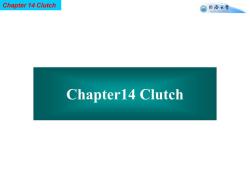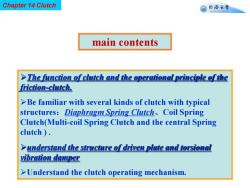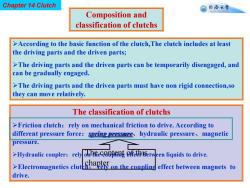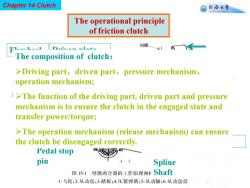同济大学:《汽车构造》课程电子教案(课件讲稿)Chapter 14 离合器 Clutch

Chapter 14 Clutch 同©大学 TONGII UNIVERSTTY Chapter14 Clutch
Chapter 14 Clutch Chapter14 Clutch

Chapter 14 Clutch 窗月桥大学 TONGII UNIVERSTTY main contents >The function of clutch and the operational principle ofthe friction-clutch. >Be familiar with several kinds of clutch with typical structures:Diaphragm Spring Clutch Coil Spring Clutch(Multi-coil Spring Clutch and the central Spring clutch ) >understand the structure of driven plate and torsional vibration damper >Understand the clutch operating mechanism
Chapter 14 Clutch main contents The function of clutch and the operational principle of the friction-clutch. Be familiar with several kinds of clutch with typical structures:Diaphragm Spring Clutch、Coil Spring Clutch(Multi-coil Spring Clutch and the central Spring clutch ) . understand the structure of driven plate and torsional vibration damper Understand the clutch operating mechanism

Chapter 14 Clutch 窗月桥大学 TONGII UNIVERSTTY First part Overview The position of clutch in the vehicle Engine-clutch- transmission >The role of a clutch:cut off the power from the engine when necessary. >The clutch is often in a combined state,only when in use it's desconnected
Chapter 14 Clutch First part Overview The role of a clutch:cut off the power from the engine when necessary. The clutch is often in a combined state, only when in use it’s desconnected。 The position of clutch in the vehicle Engine——clutch——transmission

Chapter 14 Clutch 日儕大学 TONGII UNIVERSTTY The work characteristics of clutch under various working conditions Transmission in neutral a.Start working Clutch in combination condition At the minimum stable speed clutch Start the engine to idling condition The function of clutch:1.Ensure the aged state car start smoothly Gradually release the clutch pedal and Clutch gradually into the The engine under combined state the minimum stable Step on the accelerator speed Dedal Clutch in combined state flameout Finish the start
Chapter 14 Clutch The work characteristics of clutch under various working conditions a. Start working condition Clutch in combination At the minimum stable speed The clutch is disengaged state Clutch gradually into the combined state Clutch in combined state Transmission in neutral Start the engine to idling condition Step on the clutch Hanging 1 position Gradually release the clutch pedal and Step on the accelerator pedal Finish the start Hanging 1 position directly Cause Instantaneous impact The engine under the minimum stable speed flameout If there is no clutch The function of clutch:1.Ensure the car start smoothly

Chapter 14 Clutch 日儕大学 TONGII UNIVERSTTY The work characteristics of clutch under various working conditions b.Shifting working Run in X position Clutch in combination condition clutch Step on the clutch and Clutch in disengaged state Shifting The driven gear can achieve The function of a clutch: to the 2.Ensure smooth shift work Damage to the drive Finish the shifting Clutch in combined state components
Chapter 14 Clutch b. Shifting working condition Clutch in combination The driven gear can achieve synchronization Clutch in disengaged state Clutch go gradually into the combined state Clutch in combined state Run in X position Step on the clutch and Shifting Gradually release the clutch pedal Finish the shifting engage a gear directly Have a great impact Damage to the drive components If there is no clutch The function of a clutch: 2.Ensure smooth shift work The work characteristics of clutch under various working conditions

Chapter 14 Clutch 日儕大学 TONGII UNIVERSTTY The work characteristics of clutch under various working conditions Run in X position Clutch in combination c.Emergency braking If there is no clutch Emergency braking The function of clutch:3.To prevent Have the transmission system from inerti overloading Excessive load,effect Prevent the transmission the life of the system from overloading transmission components or damage the drive element
Chapter 14 Clutch c. Emergency braking Clutch in combination Clutch trackslip Run in X position Emergency braking The force between the driving disc and the driven disc reachs the limit Prevent the transmission system from overloading Engine speed decreases sharply Have a great moment of inertia Excessive load,effect the life of the transmission components or damage the drive element If there is no clutch The function of clutch:3.To prevent the transmission system from overloading The work characteristics of clutch under various working conditions

Chapter 14 Clutch 圆日海大学 TONGII UNIVERSTTY Composition and classification of clutchs >According to the basic function of the clutch,The clutch includes at least the driving parts and the driven parts; >The driving parts and the driven parts can be temporarily disengaged,and can be gradually engaged. >The driving parts and the driven parts must have non rigid connection,so they can move relatively. The classification of clutchs >Friction clutch:rely on mechanical friction to drive.According to different pressure force:spring pressure hydraulic pressure magnetic pressure. Hydraulic coupler:rely onetween liquids to drive. Electromagnetics clut on the coupling effect between magnets to drive
Chapter 14 Clutch Composition and classification of clutchs According to the basic function of the clutch,The clutch includes at least the driving parts and the driven parts; The driving parts and the driven parts can be temporarily disengaged, and can be gradually engaged. The driving parts and the driven parts must have non rigid connection,so they can move relatively. The classification of clutchs Friction clutch:rely on mechanical friction to drive. According to different pressure force:spring pressure、hydraulic pressure、magnetic pressure. Hydraulic coupler:rely on the coupling effect between liquids to drive. Electromagnetics clutch: rely on the coupling effect between magnets to drive. The content of this chapter

Chapter 14 Clutch 月傍大学 TONGII UNIVERSITY The operational principle of friction clutch Basic knowledges: Friction force: F=uP where u-friction coefficient; Pnormal pressure. Friction force is proportional to pressure; The friction coefficient depends on the characteristic of material itself,the size of material,and surface roughness,etc. Static Friction coefficient Slipping Friction coefficient
Chapter 14 Clutch The operational principle of friction clutch Basic knowledges: Friction force: where — friction coefficient; ——normal pressure. Friction force is proportional to pressure; The friction coefficient depends on the characteristic of material itself, the size of material, and surface roughness, etc. Static Friction coefficient > Slipping Friction coefficient F P P

Chapter 14 Clutch 日儕大学 TONGII UNIVERSTTY The operational principle of friction clutch .nnla4n The composition of clutch: >Driving part,driven part,pressure mechanism operation mechanism; >The function of the driving part,driven part and pressure mechanism is to ensure the clutch in the engaged state and transfer power/torque; >The operation mechanism (release mechanism) can ensure the clutch be disengaged correctly. Pedal stop pin Spline 图i5-l唯擦离合器的工作原理和Shaft 1-飞轮;2-从动盘;3-踏板:4-压紧弹簧:5-从动轴:6从动盘镘
Chapter 14 Clutch The operational principle of friction clutch Flywheel Driven plate Pedal spring Driven shaft Hub of driven plate Engine shaft Spline Shaft Pedal stop pin The composition of clutch: Driving part、driven part、pressure mechanism、 operation mechanism; The function of the driving part, driven part and pressure mechanism is to ensure the clutch in the engaged state and transfer power/torque; The operation mechanism (release mechanism) can ensure the clutch be disengaged correctly

Chapter 14 Clutch 同©大学 TONGII UNIVERSTTY The operational principle of friction clutch Clutch pedal Clutch Flywheel cover Pressure Plate Diaphragm Driven spring plate Engage and disengage state of friction clutch
Chapter 14 Clutch Flywheel Driven plate Diaphragm spring Clutch cover Pressure Plate Clutch pedal Engage and disengage state of friction clutch The operational principle of friction clutch
按次数下载不扣除下载券;
注册用户24小时内重复下载只扣除一次;
顺序:VIP每日次数-->可用次数-->下载券;
- 同济大学:《汽车构造》课程电子教案(课件讲稿)Chapter 13 传动系统 Overview of automobile drivetrain.pdf
- 同济大学:《汽车构造》课程电子教案(课件讲稿)Automobile structure(Types of modern automobiles).pdf
- 同济大学:《汽车构造》课程电子教案(课件讲稿)第十二章 发动机有害排放物的控制系统 Control System of Harmful Emissions in Engine Exhaust.pdf
- 同济大学:《汽车构造》课程电子教案(课件讲稿)第十章 发动机点火系统 Engine Ignition System.pdf
- 同济大学:《汽车构造》课程电子教案(课件讲稿)第八章 发动机润滑系 Lubrication System for Automotive Engines.pdf
- 同济大学:《汽车构造》课程电子教案(课件讲稿)第九章 起动系统 Starting System.pdf
- 同济大学:《汽车构造》课程电子教案(课件讲稿)第七章 发动机冷却系 Cooling System.pdf
- 同济大学:《汽车构造》课程电子教案(课件讲稿)第五章 柴油机燃油供给系统 Fuel Supply System for Diesel Engines.pdf
- 同济大学:《汽车构造》课程电子教案(课件讲稿)第六章 进气、排气及增压系统 Intake, Exhaust and Boost Systems.pdf
- 同济大学:《汽车构造》课程电子教案(课件讲稿)第四章 汽油机燃油供给系统 Fuel Supply System For Gasoline Engine.pdf
- 同济大学:《汽车构造》课程电子教案(课件讲稿)第三章 配气机构 Valve Trains(负责人:李理光).pdf
- 同济大学:《汽车构造》课程电子教案(课件讲稿)第二章 机体组及曲柄连杆机构 Engine Block, Crank and Connecting Rod Mechanism.pdf
- 同济大学:《汽车构造》课程电子教案(课件讲稿)第一章 内燃机工作原理及总体构造 The Working Principles and Overall Structure of Internal Combustion Engines.pdf
- 同济大学:《Matlab在机械设计中的应用》课程电子教案(PPT课件)Chapter 11 Simulink.pptx
- 同济大学:《Matlab在机械设计中的应用》课程电子教案(PPT课件)Chapter 10 Graphical User Interface.ppt
- 同济大学:《Matlab在机械设计中的应用》课程电子教案(PPT课件)Chapter 09 Probability and statistics.ppt
- 同济大学:《Matlab在机械设计中的应用》课程电子教案(PPT课件)Chapter 08 Advanced Mathematics.ppt
- 同济大学:《Matlab在机械设计中的应用》课程电子教案(PPT课件)Chapter 07 Sparse Arrays, Cell Arrays, and Structures.ppt
- 同济大学:《Matlab在机械设计中的应用》课程电子教案(PPT课件)Chapter 06 User-defined Functions.ppt
- 同济大学:《Matlab在机械设计中的应用》课程电子教案(PPT课件)Chapter 05 Plotting.ppt
- 同济大学:《汽车构造》课程电子教案(课件讲稿)Chapter 15 变速箱 Transmission and transfer case.pdf
- 同济大学:《汽车构造》课程电子教案(课件讲稿)Chapter 16 自动变速器 Vehicle Automatic transmission.pdf
- 同济大学:《汽车构造》课程电子教案(课件讲稿)Chapter 17 传动装置 Universal Gearing.pdf
- 同济大学:《汽车构造》课程电子教案(课件讲稿)Chapter 18 驱动桥 Driving Axle.pdf
- 同济大学:《汽车构造》课程电子教案(课件讲稿)Chapter 19 传动装置 Running Gear.pdf
- 同济大学:《汽车构造》课程电子教案(课件讲稿)Chapter 20 车架和车身 Frame and Monocoque Body.pdf
- 同济大学:《汽车构造》课程电子教案(课件讲稿)Chapter 21 车轴和车轮 Axle and Wheel.pdf
- 同济大学:《汽车构造》课程电子教案(课件讲稿)Chapter 22 悬架 Suspension.pdf
- 同济大学:《汽车构造》课程电子教案(课件讲稿)Chapter 23 汽车转向系统 Steering system.pdf
- 同济大学:《汽车构造》课程电子教案(课件讲稿)Chapter 24 制动系统 Braking system.pdf
- 同济大学:《汽车构造》课程电子教案(课件讲稿)Chapter 25 车身 Car body.pdf
- 同济大学:《汽车构造》课程电子教案(课件讲稿)Hydro-mechanical Transmission and Continuously Variable Transmission.pdf
- 四川大学:制造科学与工程学院《工程测试技术与信息处理》本科课程教学大纲 Engineering Measurement and Signal Analysis.pdf
- 东华大学:《画法几何与工程制图》课程教学资源(教学大纲)画法几何与工程制图(1)Descriptive Geometry and Engineering Drawing I.doc
- 石河子大学:《人机工程学》课程教学资源(试卷习题)人机工程学习题集(无答案).doc
- 石河子大学:《人机工程学》课程教学资源(教案讲义)教学大纲 Man-Machine Engineering teaching outline.doc
- 石河子大学:《人机工程学》课程教学资源(教案讲义)人机工程学考试大纲 Man-Machine Engineering teaching outline.doc
- 《人机工程学》课程PPT教学课件(课外学习)中国台北科技大学课外学习课件.ppt
- 石河子大学:《人机工程学》课程教学资源(PPT课件)第一章 人因工程学概述 Human Factors Engineering(主讲:杨续昌).ppt
- 石河子大学:《人机工程学》课程教学资源(PPT课件)第十二章 作业空间设计.ppt
